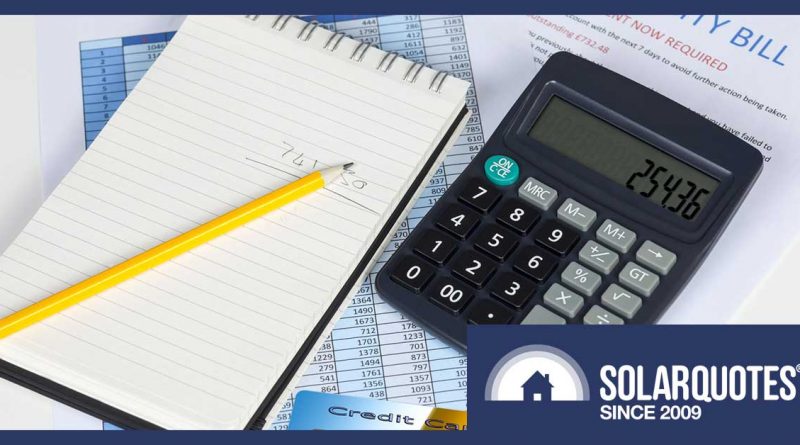Click Energy: Best Feed-in Tariffs But Not Always Best Deal

Click Energy provides high feed-in tariffs — If your inverter is 5kW or less.
If you:
- want a high solar feed-in tariff.
- have a solar inverter 5 kilowatts or less.
- have low grid electricity consumption
…then Click Energy may be the best choice of electricity retailer to minimize your electricity bills (or maximize credit received).
This is thanks to Click Energy having the highest feed-in tariffs for new solar installations I know of. Unfortunately, what they charge for grid electricity is on the high side, so if your grid consumption is high and/or solar exports low you’re likely to find a better deal elsewhere.
To indicate if Click’s high feed-in tariffs are likely to be a good deal for you, I’ve crunched numbers for every capital city where they are available.
Available Locations
You can only choose Click Energy as your electricity retailer if you live in the following exciting locations:
- New South Wales
- Victoria
- South Australia
- South East Queensland (The part that’s mostly non-fatal.)
While this includes almost all Australians who swelter under the tyranny of retailer choice, it leaves out the ACT. No doubt because Canberrans just aren’t exciting enough. (Sure, they’re interesting, but they ain’t no Radelaidians. Sadly, they’re not even as thrilling as Stradbroke Islandarians.)
Our Electricity Plan Comparison Tool Has A Problem
Normally I’d just use the SolarQuotes Electricity Retailer Comparison tool to determine what the best deal for a solar household is. Unfortunately, the little internet elves that used to provide it with information are no longer in action.
Note from Finn: We reached out to AEMO/Energy Made Easy via multiple channels and people to ask for a direct feed. They ignored every single communication. We reached out to a private data feed provider who quoted us $10k per year for a replacement feed. That seemed like a fair deal – until we saw the contract. The contract said the data-feed provider would have a veto on any application of the feed we were paying for. The provider said they would not allow us to use the data feed for our free, non-monetised electricity plan comparison tool. So we are building our own data feed. Which is a stupidly big job. Please bear with us.
While the information it presents should still be nearly all up to date I can’t be certain it’s accurate, so I’ll work out how much benefit a Click Energy plan will provide by hand.
Comparison Capitals
I’ll investigate the benefits of a Click Energy plan in every capital they’re available:
- Adelaide
- Brisbane
- Melbourne
- Sydney
I’ll let you decide for yourself if I’ve arranged these cities by alphabetical order or how awesome their inhabitants are.
Household Characteristics
I’ll determine what a reasonably typical household’s annual electricity bill will be in each capital under a Click Energy plan and compare it to the best alternative I can find. To keep things simple I’ll just consider plans with standard tariffs that charge a flat rate per kilowatt-hour of grid electricity.
For my comparison household I’ve chosen a solar system size and total annual electricity consumption that should be a good match for a Click Energy plan while still being fairly typical:
- 4,500 kilowatt-hours total annual electricity consumption.
- A 5 kilowatt solar inverter with 6.6 kilowatts of north-facing panels.
This much annual electricity consumption is fairly typical for smaller households, but may not apply for large families or those who have pools, electric cars, underfloor electric heating, or members who get too carried away with climate control.
A 6.6 kilowatt solar system is just short of the maximum panel capacity a 5 kilowatt inverter can have, which is the largest inverter capacity Click Energy allows. Because the panels face north they’ll generate the maximum amount of energy possible.
Solar Self Consumption
Solar self-consumption is how much solar energy the household consumes itself and I’ll consider two different scenarios — medium and low. I’ll look at medium self-consumption because it represents a typical household, but I’ll also specifically look at low self-consumption because I know a lot of people who are out of their home for most of the day believe electricity plans with the highest feed-in tariff are likely to be the best for them and I want to check if this is true.
Medium Solar Self Consumption: A typical household consuming around 4,500 kilowatt-hours of electricity in total per year can expect to self consume around 20% of the energy a 6.6 kilowatt solar system with north-facing panels produces. I’ll use this figure for Adelaide, Brisbane, and Sydney, but I’ll bump it up to 22% for Melbourne as lower solar generation there tends to increase self-consumption.
Medium self-consumption can represent a home where there are often people around during the day but which is still left empty for considerable stretches of time. Or it could be a home where people are usually out for most of the day but a significant effort has been made to shift electricity consumption to the daytime. For example, timers have been used to switch on water systems, pool filters, and potentially other devices during the day.
Low Solar Self Consumption: This represents a home where people are usually out during the day without a great deal of effort made to shift consumption to the daytime. I’ll assume the household uses 10% of solar energy generated except in Melbourne, where I’ll use 11%. Because more solar energy is being exported under this condition it will give Click’s high feed-in tariffs an opportunity to shine. But because it also results in higher grid consumption, Click Energy’s high per kilowatt-hour charges will take a toll. Unless you’re some sort of mathematical genius it’s not really possible to tell without crunching the numbers.
Results By City
After finding a city’s most appropriate Click Energy plan — all of which have a floral theme — I compared them to the best competing plan I could find and put the results below. Charges and feed-in tariffs are in cents and kWh stands for kilowatt-hour.
Adelaide
In Adelaide, Click Energy has two equally good plans — Flora and Flora Solar — and they went head to head with AGL Solar Savers. The two fighter’s vital statistics are:
- Click Flora Solar: Daily supply charge 101.64, kWh charge 36.52, Feed-in tariff 17 cents
- AGL Solar Savers: Daily supply Charge 88.43, kWh charge 37.73, Feed-in tariff 16 cents
Unlike in the other capitals, Click’s per kilowatt-hour charge is lower than the best alternative plan I could find for the household.
Adelaide: 20% Solar Self Consumption
With medium, 20% solar self-consumption, both plans end up in credit over a year, which means instead of paying money to the retailer they receive it. Of the two retailers Click Energy is the best and came out $64 ahead:
- Click Flora Solar: $145 Credit
- AGL Solar Savers: $81 Credit
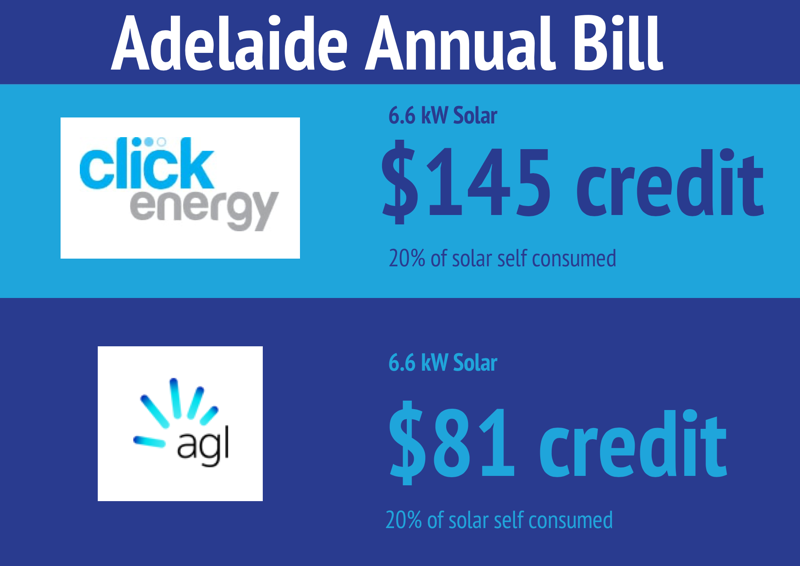
Adelaide: 10% Solar Self Consumption
With low, 10% solar self-consumption neither plan is in credit but the annual cost of electricity is still very low, with Click Energy again coming out ahead. this time by $87:
- Click Energy Flora plan: $56
- AGL Solar Savers: $143
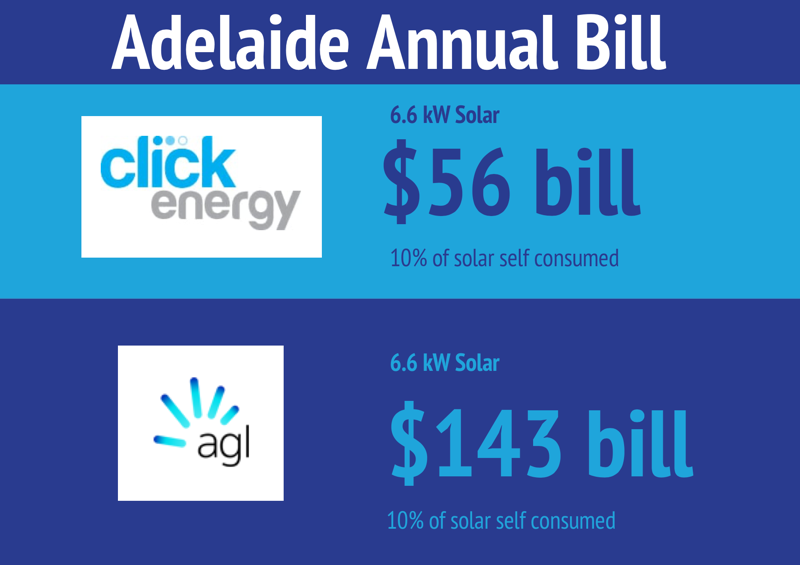
Brisbane
In Brisbane Click Flora Solar went up against AGL Solar Savers:
- Click Flora Solar: Daily supply charge 117.81, kWh charge 23.43, Feed-in tariff 12 cents
- AGL Solar Savers: Daily supply Charge 110.22, kWh charge 24.04, Feed-in tariff 15 cents
Brisbane: 20% Solar Self Consumption
Click Energy gets its clock cleaned as the AGL plan comes out well ahead in the medium 20% solar self-consumption scenario with a $266 lead:
- Click Energy Flora plan: $23 Credit
- AGL Solar Saver: $289 Credit
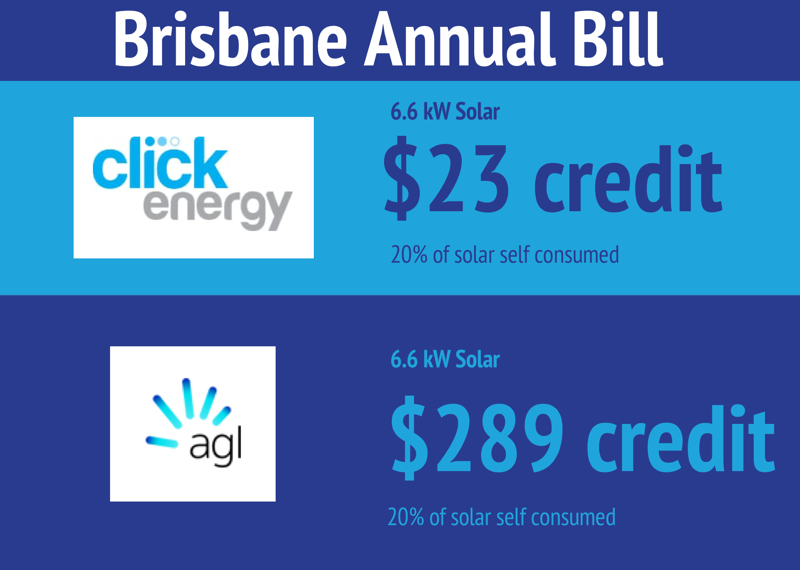
Brisbane: 10% Solar Self Consumption
AGL also comes out well ahead in the low 10% solar self-consumption scenario:
- Click Energy Flora plan: $98
- AGL Solar Saver: $193 Credit
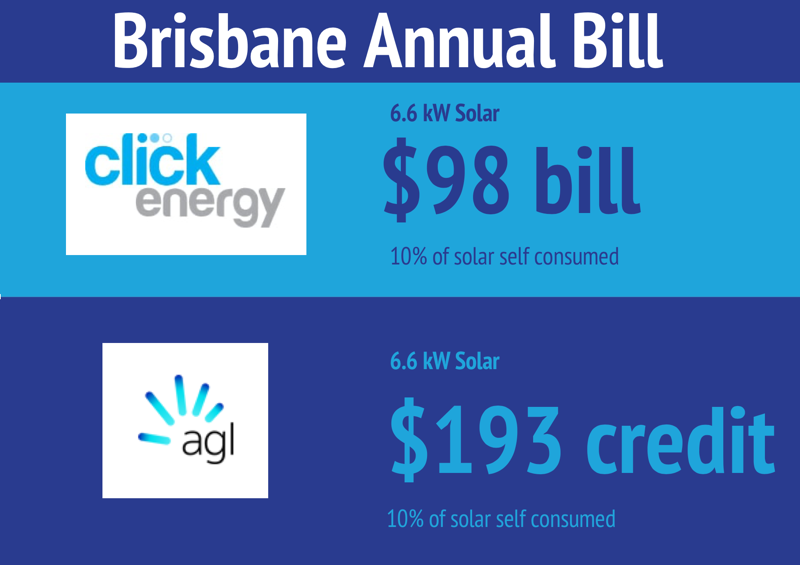
Melbourne
In Melbourne the best Click Energy plan is Click Rose Solar, while the best alternative I could find is Origin Solar Boost:
- Click Rose Solar: Daily supply charge 114.08, kWh charge 30.91, Feed-in tariff 16 cents
- Origin Solar Boost: Daily supply charge 113.09, kWh charge 25.17, Feed-in tariff 14 cents
Melbourne: 22% Solar Self Consumption
With medium 22% solar self-consumption the results are nearly a tie, with the Click plan coming out ahead by just $4. If I’d used 20% solar self-consumption as in the other cities, Origin would have come out $2 ahead:
- Click Rose Solar: $11 Credit
- Origin Solar Boost: $7 Credit
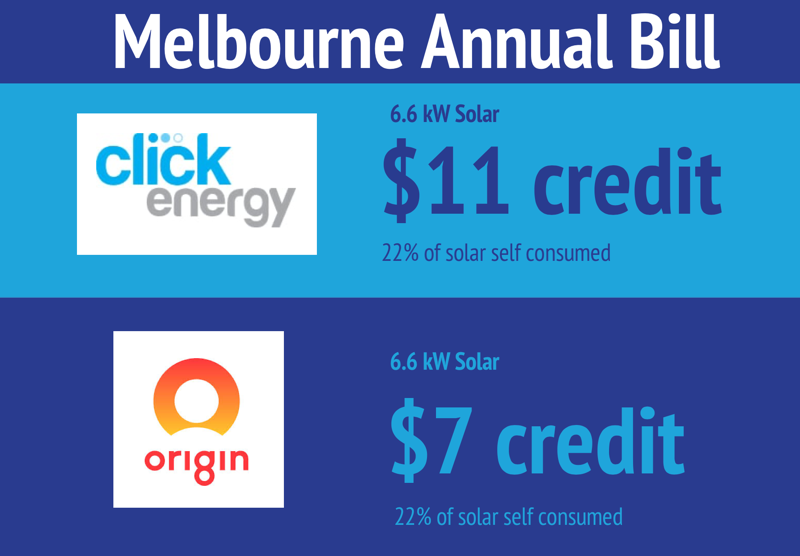
Melbourne: 11% Solar Self Consumption
The Click Energy plan’s high per kilowatt-hour charge takes the blush off the rose and allows Origin to win by $35 over the course of a year in the low 11% solar self-consumption scenario:
- Click Rose Solar: $144
- Origin Solar Boost: $109
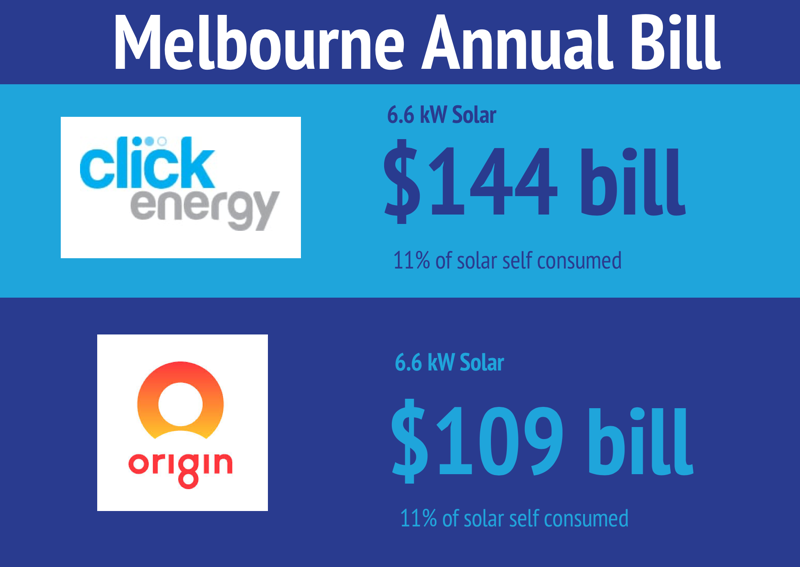
Sydney
Sydney’s best Click Energy plan is Click Flora and the most competitive alternative I found was AGL Residential Solar Savers:
- Click Flora: Daily supply charge 99, kWh charge 28.22, Feed-in tariff 16 cents
- AGL Residential Solar Savers: Daily supply Charge 110.22, kWh charge 24.04, Feed-in tariff 15 cents
Sydney: 20% Solar Self Consumption
With medium 20% solar self-consumption the Click plan is a little ahead with $13 more credit:
- Click Flora: $173 Credit
- AGL Residential Solar Savers: $160 Credit
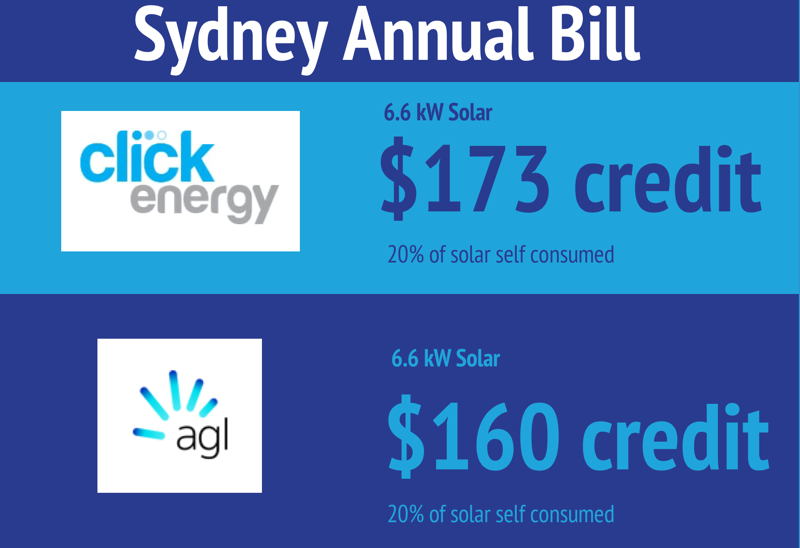
Sydney: 10% Solar Self Consumption
But with low 10% solar self-consumption, Click’s higher per kilowatt-hour charge for grid electricity allows the AGL plan to pull ahead:
- Click Flora: $54 Credit
- AGL Residential Solar Savers: $72 Credit
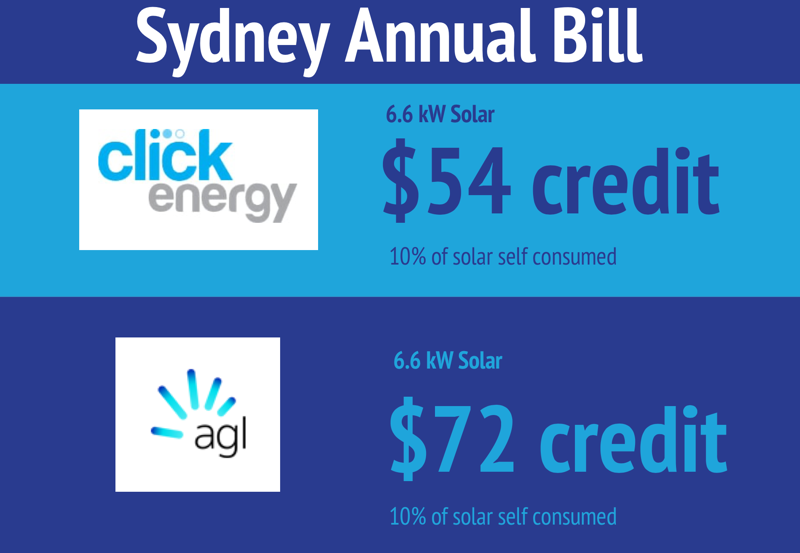
The Right Electricity Plan For The Right Situation
If we put the results into a little chart showing how far ahead or behind Click Energy came, it looks like this:

We can see that — with a solar power system of the maximum size allowed by Click Energy — a Click plan can be a good choice in Adelaide, a bad choice in Brisbane, and may be a good choice in Melbourne and Sydney. Because of Click’s high daily supply charge and high per kilowatt-hour charge, it is important that grid consumption be low enough in relation to exports to allow Click Energy high feed-in tariffs make their plans worthwhile.
Original Source: https://www.solarquotes.com.au/blog/click-energy-solar-tariff-review/




